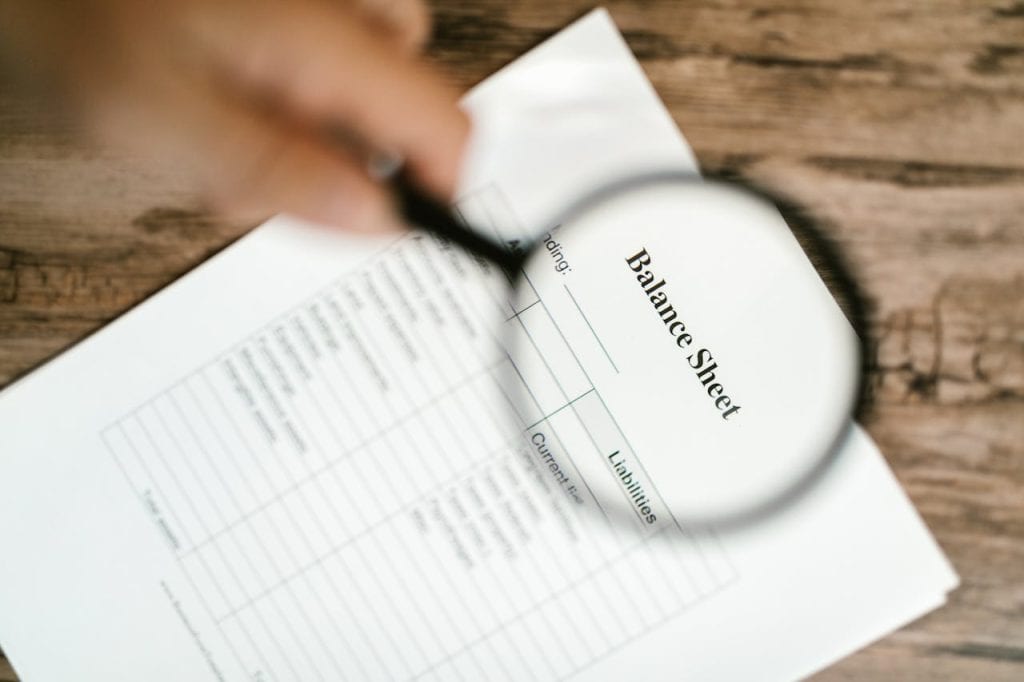- The components and elements of a balance sheet and how they indicate a company’s financial health
- The importance of a healthy balance sheet in business acquisitions and how it affects risk mitigation and negotiation power
- The strategies and tips for improving a balance sheet, such as inventory management, collection procedure, and price adjustments
- The methods and tools for analyzing the financial performance of a company, such as financial statements and ratios
- The benefits and opportunities of learning more about a healthy balance sheet from Acquira’s Accelerator program
Whether you are a business owner aspiring to expand your empire or an acquisition entrepreneur scouting lucrative opportunities, one underlying aspect always emerges as a central focus: a company’s financial health.
At the heart of this health check lies the balance sheet, a testament to a company’s economic stamina.
A strong and healthy balance sheet goes beyond having more assets than liabilities but should be able to support the business goals while maximizing performance.
Let’s take a look at what a healthy balance sheet looks like in the realm of business acquisition.
Components of a Balance Sheet
1. Assets: These represent what your business owns or controls, which can provide future economic benefits. Assets can be tangible, like machinery and inventory, or intangible, such as trademarks or copyrights. They are usually classified as current assets (those expected to be converted into cash within a year, such as accounts receivable) and non-current assets (those that provide longer-term value, like property or equipment).
2. Liabilities: These are the obligations your business owes to external parties. Like assets, they’re divided into current liabilities (debts due within a year) and long-term liabilities. This could range from short-term debts to suppliers (accounts payable) to long-term loans or mortgage obligations.
3. Equity: Often termed as “owner’s equity” or “shareholder’s equity,” this represents the residual interest in the assets of your business after liabilities are deducted. In simpler terms, it’s what’s left for the owners after all debts are paid. Equity typically comprises the initial investment, retained earnings (profits reinvested in the business), and any other capital contributions.

Elements of a Healthy Balance Sheet
To gauge the vitality of your balance sheet, you’ll need to look beyond just the raw numbers and focus on the relationships between them.
- Liquidity: This indicates how readily your assets can be converted into cash to meet short-term obligations. The Current Ratio or Liquidity Ratio (current assets divided by current liabilities) is a key metric here. A ratio greater than one suggests you have more assets than immediate liabilities, putting you in an excellent position to cover short-term debts. A commonly accepted benchmark for a healthy business is a ratio of 2:1.
- Solvency: Beyond just immediate debts, solvency measures your business’s long-term financial stability.
- A Positive Net Asset Position (where total assets exceed total liabilities) suggests good solvency. This means that if you were to settle all debts today, your business would still retain value.
- Right Amount of Key Assets: Not all assets are equally valuable. A healthy balance sheet has the right mix of assets that align with your business operations, ensuring efficiency and profitability.
- More Debtors than Creditors: If you have more people owing you money than the other way round, it’s generally a favorable position. However, ensure your debtors are reliable and pay on time.
- Fast-Moving Receivables Ledger: While having debtors is good, you want the money they owe to flow into your business quickly. A receivables ledger that turns over rapidly suggests customers pay their dues promptly, boosting your liquidity.
- Good Debt-to-Equity Ratio: This ratio provides insight into how your business is financed. A lower ratio indicates a greater proportion of owner financing (equity) compared to external debt, often signaling less risk to potential creditors.
- Profitability: While not directly a balance sheet item, profitability affects equity. Profitable businesses increase their retained earnings, thereby boosting equity. It also suggests the effective use of assets to generate revenue.
Importance of a Healthy Balance Sheet in Business Acquisitions
Risk Mitigation
A strong balance sheet diminishes risks in two primary ways.
First, it reflects a company’s minimal debt burden. Businesses with less debt are less beholden to creditors, allowing for greater flexibility in decision-making post-acquisition.
| Need help analyzing a business: Try our Quality of Earnings service! |
Second, a firm balance sheet demonstrates a company’s ability to handle operational challenges. Should unexpected market fluctuations or operational disruptions occur, a company with a substantial reserve of assets can navigate these waters with increased dexterity.
Negotiation Power
From a seller’s perspective, a formidable balance sheet is a testament to sound business practices and the ability to generate consistent profit.
It can justify higher valuations and can be wielded to secure favorable terms.
On the other hand, buyers can leverage the intricacies of a target company’s balance sheet to their advantage.
Recognizing vulnerabilities, be it in high short-term debts or inconsistent revenue streams, can afford buyers the upper hand in steering negotiation outcomes.
Strategies for Improving Balance Sheets
Now let’s look at ways to improve a balance sheet:
- Improve Inventory Management: An optimal inventory aligns with market demand. Overstocking drains resources through holding costs, while understocking can lead to lost sales opportunities.
- Review Collection Procedure: Cash flow is the lifeblood of any business. Companies can bolster their liquid assets by ensuring that customer payments are collected promptly.
- Assess Non-income Producing Assets: If certain assets, such as unused equipment or property, aren’t generating income or potential growth, it might be wise to consider divesting.
- Reduce Staffing Costs: Human resources are valuable, but it’s essential to ensure that staffing levels align with operational demands. This doesn’t necessarily mean layoffs. It could involve strategies like cross-training employees for multiple roles or adopting technology solutions that enhance productivity.
- Conduct Price Adjustments: Regularly reviewing and adjusting product or service pricing ensures that businesses are neither underselling their value nor alienating potential customers with high prices.
How to Check the Financial Health of a Company?

Analyze Balance Sheet: A balance sheet provides a snapshot of a company’s financial position at a particular time.
Healthy companies typically have a solid balance between its three components, with assets exceeding liabilities, indicating good financial health.
| Read more: How To Read Financial Statements |
Analyze Income Statement: This document provides insights into a company’s profitability over a specific period.
You can gauge how well a company performs operationally by evaluating revenues, expenses, and net income. A consistently growing net income is a sign of a thriving business.
Analyze Cash Flow Statement: The cash flow statement breaks down how cash is moving in and out of the business.
It’s divided into three sections: operations, investing, and financing.
Positive operating cash flow suggests the core business activities generate cash, a vital sign of financial health.
Financial Ratio Analysis: Ratios offer a quick way to assess a company’s financial health.
Some essential ratios include the current ratio (liquidity measure), debt-to-equity ratio (leverage measure), and return on equity (profitability measure).
When compared to industry benchmarks or competitors, these ratios provide a relative understanding of the company’s financial standing.
Regularly scrutinizing these financial documents and ratios provides a comprehensive understanding of a company’s economic vitality.
It’s crucial to not only examine individual figures but to look for trends over time to get a holistic view of the company’s financial trajectory.
FAQs
A high-quality balance sheet boasts a favorable mix of short and long-term assets, minimal unproductive assets, low debt relative to equity, and a robust liquidity position. It reflects the company’s capacity to meet its obligations and invest in future opportunities.
A healthy balance sheet displays strong financial health, indicating sufficient assets to cover liabilities. It fosters trust among stakeholders, offers better loan terms, and supports business growth through increased opportunities and resilience against economic downturns.
Analyzing financial performance helps stakeholders gauge a company’s profitability, liquidity, and solvency. Regular reviews can highlight strengths, reveal areas of concern, guide decision-making, and evaluate the impact of strategic choices on financial health.
A negative balance sheet implies liabilities exceed assets. This might indicate financial distress or poor management. Such a scenario can affect a company’s ability to secure loans, attract investors, or even remain solvent, potentially leading to bankruptcy if not addressed promptly.
Conclusion
A company’s balance sheet is a cornerstone of its financial health, highlighting its assets, liabilities, and equity.
A healthy balance sheet is vital in the context of business acquisitions, offering risk mitigation advantages and more substantial negotiation power.
A healthy balance sheet is vital in the context of business acquisitions, offering risk mitigation advantages and more substantial negotiation power.
Liquidity, solvency, and the right mix of assets are pivotal elements to consider in evaluating balance sheet strength.
To further enhance a balance sheet, businesses should employ strategies like optimizing inventory management, refining collection procedures, and making prudent staffing and pricing decisions.
Are you a small business owner considering selling your business? Acquira can help connect you with qualified buyers who have completed our training and are ready to buy a business now. Fill out the valuation form below to see how much your business is worth. If you meet our qualifications, schedule a call to learn how we can help!
Key Takeaways
- A healthy balance sheet reflects a company’s ability to cover short-term and long-term obligations.
- Liquidity measures a business’s readiness to meet immediate debts, with a 2:1 ratio being a positive indicator.
- A strong balance sheet boosts negotiation power in acquisition deals, benefiting both buyers and sellers.
- Regularly analyzing financial statements gives a holistic view of a company’s financial trajectory.
- A fortified balance sheet for business acquisitions is paramount, minimizing risks and maximizing opportunities.
Acquira specializes in seamless business succession and acquisition. We guide entrepreneurs in acquiring businesses and investing in their growth and success. Our focus is on creating a lasting, positive impact for owners, employees, and the community through each transition.


